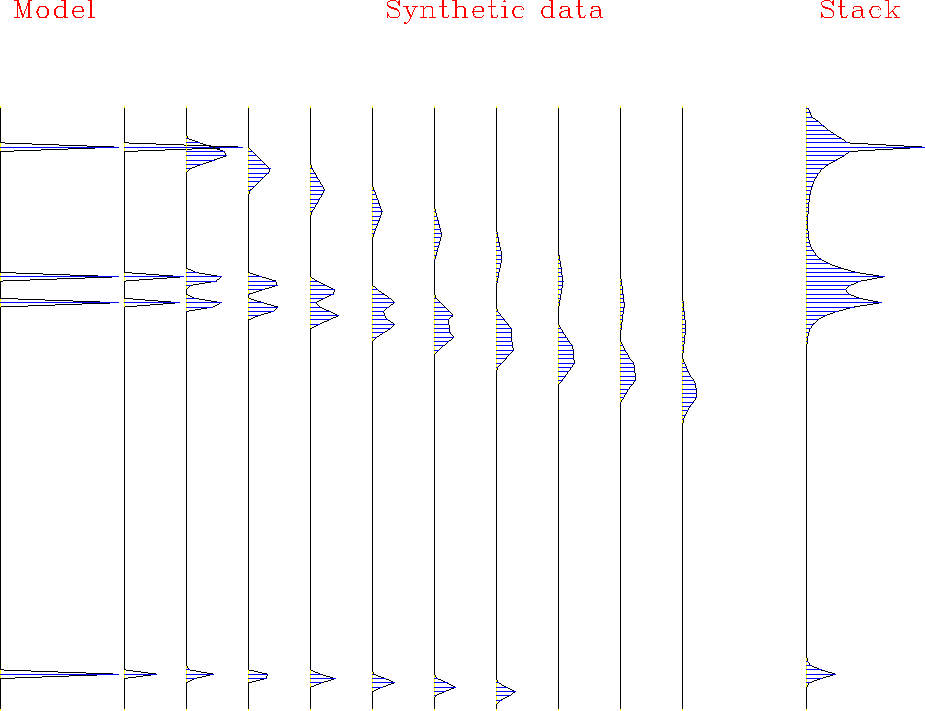We should take some care with anti-aliasing in data processing. The anti-aliasing measures we take, however, need not match the field recording. If the field arrays were rectangles, we could use triangles or sincs in the data processing. It happens that triangles are an easy extension of the rectangle work we have been doing and triangles make a big step in the right direction.
For an input pulse, the output of integration is a step. The output of a second integration is a ramp. For an input triplet (1, 0, 0, -2, 0, 0, 1) the output of two integrations is a short triangle. An easy way to assure time alignment of the triangle center with the triplet center is to integrate once causally and once anticausally as done in subroutine doubint().
You can imagine placing the ends and apex of each triangle at a nearest neighbor mesh point as we did with the rectangles. Instead I place these ends more precisely on the mesh with linear interpolation using subroutine spotw() which adds or extracts a value to any location on a vector where the value may lie between mesh points.
# Scaled linear interpolation.
#
subroutine spotw( conj, add, scale, nt,t0,dt, t, val, vec )
integer it,itc, conj, add, nt
real tc, fraction, scale, t0,dt, t, val, vec(nt)
call conjnull( conj, add, val,1, vec,nt)
tc = (t-t0) / dt; itc = tc; it = 1 + itc; fraction = tc - itc
if( 1 <= it & it < nt) {
if( conj == 0) {
vec(it ) = vec(it ) + (1.-fraction) * val * scale
vec(it+1) = vec(it+1) + fraction * val * scale
}
else
val = val + ((1.-fraction) * vec(it) +
fraction * vec(it+1) ) * scale
}
else
call erexit('spotw: at boundary')
return; end
Using these subroutines,
I assembled the stacking subroutine tristack()
and the NMO routine trimo() with triangle wavelets.
The triangle routines are like those for rectangles
except for some minor changes.
Instead of computing the theoretical locations
of impulses on nearer and further traces,
I assumed a straight line tangent to the hyperbola
![]() .Differentiating by x at constant
.Differentiating by x at constant ![]() gives the slope
dt/dx= x/(v2t).
As before, the area of the the wavelets, now triangles must be preserved.
The area of a triangle is proportional to the base times the height.
Since the triangles are built from double integration ramp functions,
the height is proportional to the base length.
Thus to preserve areas, each wavelet is scaled by the inverse squared
of the triangle's base length.
Results are shown in
Figures 6 and 7.
gives the slope
dt/dx= x/(v2t).
As before, the area of the the wavelets, now triangles must be preserved.
The area of a triangle is proportional to the base times the height.
Since the triangles are built from double integration ramp functions,
the height is proportional to the base length.
Thus to preserve areas, each wavelet is scaled by the inverse squared
of the triangle's base length.
Results are shown in
Figures 6 and 7.
|
trimo0
Figure 6 Triangle wavelets, accurately positioned, but aliased (antialias=0.) |  |
|
trimo1
Figure 7 Antialiased triangle wavelets. (antialias=1.) Where ever triangle duration is more than about three points, the end of one triangle marks the apex of the next. |  |
# Modeling and stacking using triangle weighted moveout.
#
subroutine tristack( conj,add, slow,anti,t0,dt,x0,dx, nt,nx, stack, gather )
integer ix, conj,add, nt,nx
real x, slow(nt),anti,t0,dt,x0,dx, stack(nt), gather(nt,nx)
call conjnull( conj, add, stack,nt, gather,nt*nx)
do ix= 1, nx { x = x0 + dx * (ix-1)
call trimo(conj,1,t0,dt,dx, x, nt,slow,0.,1.,anti,stack, gather(1,ix))
}
return; end
# moveout with triangle shaped smoothing window.
#
subroutine trimo( conj, add, t0,dt, dx,x, nt, slow, s02, wt, anti, zz, tt )
integer iz,itp,itm, conj, add, nt
real t0,dt, dx,x, slow(nt), s02, wt, anti, zz(nt),tt(nt)
real z, t,tm,tp, amp, slope
temporary real ss(nt)
call null( ss,nt); call conjnull( conj, add, zz,nt, tt,nt)
if( conj != 0 ) call doubint( 1, 0, nt, ss, tt)
do iz= 1, nt { z = t0 + dt * (iz-1)
t = sqrt( z**2 + (slow(iz) * x)**2 )
slope = anti * ( slow(iz) * slow(iz) - s02 ) * x / (t+dt)
tp = t + abs(slope * dx) + dt; itp = 1.5 + (tp-t0) / dt
tm = t - abs(slope * dx) - dt; itm = 1.5 + (tm-t0) / dt
if( itm <= 1 ) next
if( itp >= nt ) break
amp = wt * sqrt( nt*dt/(t+dt)) * (z+dt)/(t+dt) * (dt/(dt+tp-tm)) ** 2
call spotw( conj, 1, -amp, nt,t0,dt,tm, zz(iz), ss)
call spotw( conj, 1, 2*amp, nt,t0,dt,t , zz(iz), ss)
call spotw( conj, 1, -amp, nt,t0,dt,tp, zz(iz), ss)
}
if( conj == 0) call doubint( 0, add, nt, ss, tt)
return; end